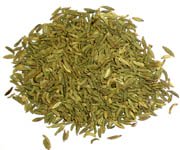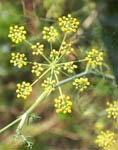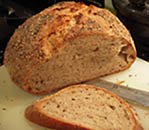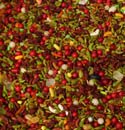Fennel seed nutrition facts
Sweet, anise-flavored fennel seed together with thyme, nettle, mugwort, etc., has been revered as one of the nine Anglo-Saxon sacred herbs for its exceptional health benefits. Spice is one of the most sought-after ingredients in many popular cuisines all over the Mediterranean region.
Fennel is a perennial herb belonging to the parsley (Umbelliferae) family; a large family of herbs and spices which also includes some of the other common members such as caraway, dill, anise, cumin, etc. Scientific name of fennel is Foeniculum vulgare var. dulce.
 |
 |
| Close-up view of fennel (F. vulgare) seeds. Note for light green color fennel, resembling anise seeds. | Fennel plant with golden-yellow flowers in umbels. Courtesy: fcw |
Fennel is native to Southern Europe and has grown extensively all over Europe, the Middle East, China, India, and Turkey. This herbaceous plant reaches up to 2 meters (about 6 feet) in height with deep green feathery (lacy) leaves and bears golden-yellow flowers in umbels. In general, fennel seeds are harvested when their seed heads turn light brown. The seeds, which closely resemble anise seeds in appearance, feature an oblong or curved (comma) shape, about 3-4 mm long, light brown with fine vertical stripes over their surface.
In general, fennels are harvested during the early hours of the day to avoid the loss of seeds in the field. As in caraway, its stems were stacked until they were dry and then threshed, and processed before dispatching to the markets.
Fennel bulb (Foeniculum vulgare var. azoricum), used as a vegetable, is closely related to seeding fennel. It has grown for its anise-flavored sweet taste fronds in many parts of the Mediterranean region.
Health benefits of Fennel seeds
Fennel symbolizes longevity, courage, and strength. In addition to its use as medicinal value, fennel has many health-benefiting nutrients, essential compounds, antioxidants, dietary fiber, minerals, and vitamins.
Fennel seeds indeed contain numerous flavonoid anti-oxidants like kaempferol and quercetin. These compounds function as powerful antioxidants by removing harmful free radicals from the body thus offering protection from cancers, infection, aging, and degenerative neurological diseases.
Like in caraway, fennel seeds also are a rich source of dietary fiber. 100 g seeds provide 39.8 g of fiber. Much of this roughage is metabolically inert insoluble fiber, which helps increase the bulk of the food by absorbing water throughout the digestive system and easing constipation problems.
Further, dietary fibers bind to bile salts (produced from cholesterol) and decrease their re-absorption in the colon. It thus helps lower serum LDL cholesterol levels. Together with flavonoid anti-oxidants, the fiber composition of the fennel helps protect the colon mucosa from cancers.
Fennel seeds are composed of health-benefiting volatile essential oil compounds such as anethole, limonene, anisic aldehyde, pinene, myrcene, fenchone, chavicol, and cineole. These active principles in the fennel are known to have antioxidant, digestive, carminative, and anti-flatulent properties.
Fennel seeds concentrated source of minerals like copper, iron, calcium, potassium, manganese, selenium, zinc, and magnesium. Copper is essential for the production of red blood cells. Iron is required for red blood cell formation. Zinc is a co-factor in many enzymes that regulate growth and development, sperm generation, digestion, and nucleic acid synthesis. Potassium is an important component of cells and body fluids that helps control heart rate and blood pressure. The human body uses manganese as a cofactor for the important antioxidant enzyme, superoxide dismutase.
Furthermore, fennel seeds indeed are the storehouse for many vital vitamins. Vitamin A, vitamin E, and vitamin C as well as many B-complex vitamins like thiamin, pyridoxine, riboflavin, and niacin particularly are concentrated in these seeds.
| Principle | Nutrient Value | Percent of RDA |
|---|---|---|
| Energy | 345 Kcal | 17% |
| Carbohydrates | 52.29 g | 40% |
| Protein | 15.80 g | 28% |
| Total Fat | 14.87 g | 48% |
| Cholesterol | 0 mg | 0% |
| Dietary Fiber | 39.8 g | 104% |
| Vitamins | ||
| Niacin | 6.050 mg | 37% |
| Pyridoxine | 0.470 mg | 36% |
| Riboflavin | 0.353 mg | 28% |
| Thiamin | 0.408 mg | 34% |
| Vitamin A | 135 IU | 4.5% |
| Vitamin C | 21 mg | 35% |
| Electrolytes | ||
| Sodium | 88 mg | 6% |
| Potassium | 1694 mg | 36% |
| Minerals | ||
| Calcium | 1196 mg | 120% |
| Copper | 1.067 mg | 118% |
| Iron | 18.54 mg | 232% |
| Magnesium | 385 mg | 96% |
| Manganese | 6.533 mg | 284% |
| Phosphorus | 487 mg | 70% |
| Zinc | 3.70 mg | 33.5% |
Selection and storage
Fennel seeds are available year-round in the markets either in the form of seeds or processed ground form. In the store, buy whole fennel seeds instead of powder since oftentimes they may contain adulterated spicy powders.
Store dry fennel seeds as you do in case of other seeds like caraway, dill, etc. Place whole seeds in a clean air-seal container and store them in a cool, humid-free, and dark place. Ground and powdered fennel should be stored in the refrigerator in airtight containers and should be used sooner since it loses flavor quickly due to the evaporation of its essential oils.
Medicinal uses
Fennel has long been used as a remedy for flatulence and indigestion in traditional medicines.
Fennel seed decoction or added as a spice in food has been found to increase breast milk secretion in nursing mothers.
Fennel water often is used in newborn babies to relieve colic pain and help aid digestion.
Fennel seed oil is used to relieve coughs, and bronchitis and as a massage oil to cure joint pains.
Culinary uses
Fennel seeds exude anise-like sweet fruity aroma when rubbed between fingers. Its herb parts, including tender growing tips, root-bulb, dried stalks, and seeds are used extensively in a wide variety of dishes all over the world.
In order to keep their fragrance and flavor intact, fennel is generally milled just before preparing dishes, or whole seeds are gently toasted under light heat before using them in a recipe.
Here are some serving tips:
 |
 |
| Light rye sourdough bread with fennel, sesame, and poppy seeds. Photo courtesy: matthewfugel |
Flavorful fennel seeds are used as a condiment in India and Pakistan. |
-
Fennel seed is widely used as a savory spice. It is one of the ingredient in popular Chinese five spice mixture along with Star anise, cinnamon, sichuan peppercorns and cloves.
- It is added mainly in cooking as a condiment and flavoring base.
Its seeds are widely used in fish, cheese spreads, and vegetable dishes.
In India, its seeds are being used as part of curry powder (Bengali paanch pooran). Also, sugar-coated fennel seeds (saunf) have been used as a condiment after food to improve digestion in India, Pakistan, and Bangladesh.
-
As in caraway, fennel seeds are used to flavor bread, dough, cakes, biscuits, and cheese.
Safety profile
Do not consume fennel seeds in large amounts. Compounds in fennel may be neurotoxic in higher concentrations and may cause hallucinations and seizures. It may exacerbate estrogen receptor-linked cancer conditions like endometrial, breast, ovarian, etc., due to the high concentration of estrogenic compounds in it. Pregnant women may be advised to avoid eating fennel in large amounts.
(Medical disclaimer: The information and reference guides on this website are intended solely for the general information of the reader. It is not to be used to diagnose health problems or for treatment purposes. It is not a substitute for medical care provided by a licensed and qualified health professional. Please consult your health care provider for any advice on medications).
≻≻-Read about Sweet Fennel (Florence fennel) nutrition facts and health benefits.
≻≻-Back to Spices from Fennel Seed. Visit here for an impressive list of healthy spices with complete illustrations of their nutrition facts and health benefits.
≻≻-Back to Home page.
Further reading:
Gernot-Katzer's spice pages. (Opens in a new window).